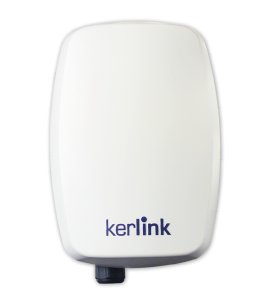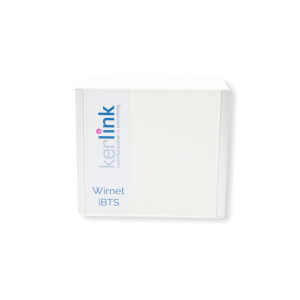Urban Operations
Smart Parking

The increasing number of vehicles in densely populated areas and the poor management of available parking spaces leads to increasing traffic congestion and waste of time. According to a report published by INRIX research in 2017[1], Americans spend an average of 17 hours per year and 20 minutes per trip only searching for parking, resulting in a cost of $345 per driver in wasted time, fuel and emissions (for a total cost estimate of $73 billion each year). An estimated 30% of traffic in urban areas already congested streets is caused by cars looking for parking[2]. This additional circulation increases traffic and vehicle miles travelled which means more pollutants emission and indirect waste of money. The overall productivity is thus affected by people being late for work, school and other appointments[3]. Inappropriate and poor parking management means revenue loss for cities, parking operators and parking lot owners, impact on local economic growth and degraded quality of life in many cities. Improving the way available parking spaces are managed, designing new parking pricing models, protecting private parking and handicapped spaces utilization, making parking accessibility more flexible and minimizing the impact of related traffic on air pollution are definitely some of the key challenges in the design and planning of the city of the future.
Deploying smart IoT sensors and devices in public parking, private parking lots and on-street parking spaces can help to monitor occupancy and quickly identify vacant spaces. Occupancy IoT sensors can detect if the space is free or not and can dynamically send information to a central application in the cloud that will offer instant visibility on parking overall availability. These IoT sensors and devices are connected with gateways that ensure the right connectivity, even in underground parking locations and dense concrete environment, and transmit the data collected. Smart parking solutions can also use other types of sensing devices like counting equipment (number of vehicles getting in and out), cameras or ultrasonic detection sensors. Smart parking applications can then deliver parking analytics for parking managers and push dynamic messaging to drivers through digital displays, short messages, in-car navigation devices or smartphones traffic apps. These solutions can also enable innovative parking business model and pricing, offering for example, booking options. Parking bays and parking meters can also be connected to enable payment options, collect real-time information on vacant parking spaces and send data for parking analytics.
Leveraging Kerlink industrial-grade IoT connectivity, powered by LoRaWAN technology, can efficiently help to implement intelligent smart parking solutions. Facility managers, parking operators and city leaders can use sensing and counting parking systems to increase the efficiency of their parking facilities, optimize occupancy, analyze parking trends and patterns and maximize revenue. They can, at the same time, reduce their operating costs, avoid vacant spaces and contribute to traffic congestion and air pollution reduction. Kerlink carrier-grade IoT indoor and outdoor gateways and network management tools, designed for public and private IoT networks, bring versatile IoT coverage to connect smart parking solutions in demanding parking environment like undergrounds, basements and indoor locations. Using Kerlink carrier-grade LoRaWAN gateways accelerates smart parking solutions deployments in private parking lots, airports, hospitals, universities, hotels, shopping malls, performance and cultural venues, exhibition areas or public parking garages, among many other places. Smart cities designers can also leverage the power of smart parking solutions to dynamically optimize space allocation to cope with an increasingly tight and busy urban environment. From an end-user perspective, smart parking solutions can reduce the stress associated with finding the right parking space, while improving the feeling to contribute to less road congestion and better utilization of city parking capacities.
[2] https://www.transportation.gov
Smart Streetlighting
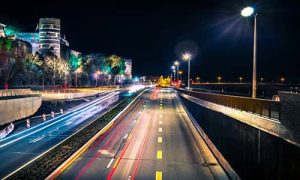
Street lighting is estimated to consume as much as 40% of power in cities[1]. Cities are increasingly investing in energy-efficient street lighting by replacing lights with new generation Light-Emitting Diode (LED) luminaires that lower energy consumption and significantly reduce operation and maintenance costs[2]. LED modules offer an average lasting of more than 150,000 hours with a predictable product lifetime of more than 15 years[3] and allows 63% energy savings from previous high-pressure sodium units. The development of LED luminaires, that will represent 73% of the total installed base by the end of the decade, is also driving the development of smart street lighting to enable cities to manage overall energy consumption more efficiently. Controllers and Control Management Systems (CMS) platforms help to manage and control connected street lights, to achieve adaptive lighting management for brightness / light (lumen) output (dimming) based on certain events or outdoor environmental conditions like ambient lighting, traffic density, parked vehicles, intersections/interchanges, and car/pedestrian/bicycle interaction. LED luminaires can also collect up to 20 different metrics like energy usage, outage management, proactive maintenance, asset information or event-based alerts using connected IoT sensors, among others. Last, but not least, the LED luminaire’s GPS information is collected during the installation and initial commissioning process and enables a precise mapping of the city to use connected luminaires as reference points. However, approximately only 3% of the 326+ million streetlamps worldwide – growing to over 361 million by 2029 – have been connected so far. Smart street lights have grown at a robust CAGR of 52% since 2012 and will maintain steady growth through the 2020s and the ratio of streetlights connected to CMS should reach 18% by 2023[4]. Total investment in LED and smart street lighting, as well as additional smart city sensors attached to streetlight infrastructure, will reach $28.1 billion over the next decade[5].
Smart street lights connected to an industrial-grade IoT network can help to deliver the key capabilities for dynamic dimming to optimize the use of lighting in local environment, for failure detection and information proactive collection on identified issues – faulty lamps, power supply failures, – and for assets management and control in real-time – impairments and damages, dysfunction -. Street lights data collection and aggregation can be achieved through carrier-grade gateways and backhauled either through cellular connections, non-cellular LPWA networks or fixed-line Ethernet connections directly to the CMS platforms to deliver useful and actionable information for faster and better decision-making. Such intelligent gateways are also increasingly embedding edge computing capabilities to process information in real time at the edge of the streetlamp, and not in the cloud. Gateway architecture and intelligence will consequently expand their capabilities to enable and manage complimentary value-add services.
Implementing smart street lighting systems can deliver a return on investment within five years, as smart street lights enable cities to more efficiently manage energy. Smart LED lights can turn on and off intelligently and adjust brightness based on ambient lighting: by centralizing and streamlining the control and maintenance of street lighting with intelligent CMS, cities can achieve a 70-75% reduction in energy costs, and save around 80% on maintenance costs. But even more interesting, the ubiquitous nature of streetlamps makes them an obvious candidate for supporting a citywide network for Smart City applications. Gartner even introduces the concept of “intelligent street poles”[6], “an evolution of smart streetlighting” and expects them to become “valuable real estate”. In 2020, streetlamps become the primary network infrastructure for 80% of Smart Cities: luminaires are not only able to host many sensors and leverage location services but can also act as the city connectivity backbone[7] for applications like interactive lighting, metering, weather analysis, pollution detection, parking management, gunshot detection, car / bike / people counting, context-based analytics & information display, asset management in vicinity of smart buildings and real estate or EV charging stations operations… And to achieve this, the choice of an industrial-grade IoT connectivity, able to grant the versatile, robust and performant coverage over time is key. And this is exactly what Kerlink is expert at delivering!
[1] ABI Research (2016), “Competitive Analysis of Smart Street Lighting Platforms”, 10 November 2016, 12 pages
[2] ABI Research (2018c), “Analyzing the market adoption of LED Streetlights versus Smart Streetlights”, October 2018, 3 pages
[3] ABI Research (2018c)
[4] Gartner (2017), “Smart Streetlamps – The Network Backbone of the Smart City”, 23 June 2017, 12 pages / ABI Research (2016)
[5] http://www.northeast-group.com/
[6] Gartner “Hype Cycle for Smart City Technologies and Solutions, 2020”, 4 August 2020, Bettina Tratz-Ryan, Bill Finnerty.
[7] Gartner (2017)
Smart Waste & Refuse
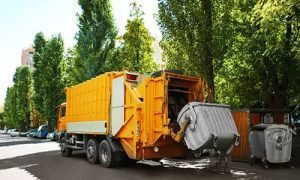
Population growth, increasing urbanization and rapid industrialization across regions are producing a growing volume of waste and refuse that is progressively becoming a major threat to cities, communities and environment. The management of these civilization by-products is an increasing concern and challenge for municipalities that have to adapt their cleaning, collection and treatment capacities. According to the World Bank, about 1.3 billion metric ton of waste and refuse is generated every year worldwide and this volume is expected to reach 2.3 billion tons by the end of 2025 and to rise by 70% to 3.4 billion tons by 2050[1]. If waste collection is an essential city service, waste management systems however still remain highly resource-intensive, partly inefficient and, for most of them, outdated. Waste management industrial value chain involves many activities such as collection, transportation, disposal and recycling, with challenging operational costs. Additionally, the need to comply with increasingly demanding environmental regulations make it paramount to look at new opportunities to reinvestigate operations. The Internet of Things (IoT) thus brings the potential to optimize and streamline collection and transportation services and to reduce operational costs for cities by almost 50%[2]. Smart waste management is increasingly becoming part of the key development topics of smart cities to improve budget allocation in order to provide a better quality of life in urban areas. The smart waste management market was valued at USD 1.77 billion in 2020 and is expected to reach USD 6.52 billion by 2026, registering a CAGR of 25.7%[3].
The most common application of IoT in waste management starts with equipping waste bins, trash bins and other recycling containers receptacles with ultrasound fill-level IoT sensors. These IoT devices permanently monitor the level of garbage in the bins and containers and notify maintenance personnel when the bins are full and ready to be emptied. Bins can also be tagged as assets, registered in a data base, and geolocated when installed so as to be mapped for easier and quick identification when a notification is received. The data is then collected by an IoT network and sent to a cloud-based Smart Waste Management System (SWMS) to provide waste management cities operators and private sub-contractors with relevant information for data-driven decision making. Once waste levels are collected in near real-time, the Smart Waste Management System helps to efficiently plan the waste collection routes and frequencies, based on bins location / type / weight / volume, collection vehicles loads and landfills / incineration sites, making sure to maximize the utilization of required resources (fleet, FTEs, fuel and time). Over time, IoT sensors and devices, combined with SWMS, can help to generate historical data to identify fill patterns and trends, adapt bins to local needs, optimize routes and streamline fleet management to reduce overall operational costs.
Leveraging Kerlink industrial-grade IoT connectivity, powered by LoRaWAN technology, can efficiently help administrations, cities, municipalities and private businesses and industries facing waste management challenges to meet increasingly stringent objectives and anti-pollution regulations. Operators are continuously forced to reduce the overall production of waste and to increase its recovery and recycling through sustainable disposal methods and better processes, while at the same time maintaining their profitability. Using Kerlink carrier-grade LoRaWAN gateways to create a long-range low-power versatile IoT network can help to easily deploy sustainable and efficient smart waste management solutions. Bidirectional robust connectivity enables to monitor bins and get notifications. Native network-based geolocation helps to track and locate bins, containers and trucks without the need to add costly and energy-hungry GPS devices. Industrial-grade LoRaWAN gateways and network management tools enable cities operators to independently make the most of their assets, deploy cost-efficient multi-purpose robust and performant IoT network and enjoy a clear and quick return on investment (ROI). Implementing Smart Waste Management solutions, powered by Kerlink IoT expertise, also helps to achieve environmental sustainability and mitigate the environmental impact of waste generation, for an overall better service to city inhabitants and citizens well-being.
[1] https://www.mordorintelligence.com
[2] https://www.futuremarketinsights.com
[3] https://www.mordorintelligence.com
Smart Traffic
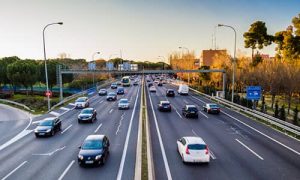
Increasing urbanization and population growth in cities – 68% of the world’s population is expected to live in urban areas by 2050 according to the UN[1] – comes with more numerous vehicles on the roads, leading to increasing traffic density, greater traffic jams and longer commutes. If urban living can generate greats benefits, it can also generate great challenges for urban mobility: traffic congestion represents a significant and frustrating experience to urban residents. Many of the world’s most congested cities have substantial problems when it comes to traffic management: the INRIX Global Traffic Scorecard[2] shows that, for the top ten cities in the world, between 130 and 85 hours have been lost per driver in congestion during 2020 (even if the traffic has been reduced due to the pandemics). Traffic management has thus become a big challenge from large cities to small communities all around the world. Cities managers need to get timely traffic information to make the right decision and anticipate traffic patterns and peaks and so must rely on intelligent traffic systems for traffic data acquisition, traffic control and traffic management. Getting real-time information can help to dynamically manage traffic congestion, optimize routes and journeys and govern traffic flows, not only for the benefit of drivers but also for those of people using public transportation like buses. According to a report by McKinsey, Intelligent syncing of traffic signals has the potential to reduce average commutes by more than 5 percent in developing cities where most people travel by bus[3]. On its side, Juniper Research estimates that smart traffic management systems will save cities $277 billion by 2025, by reducing traffic congestion and traffic emissions alongside, and the average motorist will spend 33 hours less in traffic each year because of connected and automated traffic lights, particularly in areas of high traffic, managing traffic flows in real-time with advanced analytics software[4].
An intelligent Smart Traffic Management System (TMS) usually consists of several components such as wireless IoT sensors and devices, wired CCTV cameras, connected traffic lights or remotely managed traffic displays and signs, strategically placed in high traffic junctions and areas where vehicles can be diverted. This combination of centrally-controlled and operated means help to monitor the flow of traffic and to regulate it in response to specific demand levels. IoT sensors and devices can help to track and count the number of vehicles in real-time. IoT sensors can also be mounted on traffic lights to monitor weather conditions, measure daylight or detect murky weather so as to increase or reduce traffic lights brightness or to adapt traffic lights timing and cycles accordingly. If too many vehicles are detected by IoT sensors, traffic lights can be used to contain the congestion in a particular area or to smooth traffic load. IoT technologies car also enable drivers’ proactive information with smart signs and smart signage to deliver real-time, location-based and traffic-related notifications and announcements. Connected IoT sensors and devices can analyze environment and traffic conditions and generate weather- or traffic-based triggers for digital signage’s and road signs’ dynamic reaction, messaging and display. Wired CCTVs cameras, mounted on traffic lights, can capture traffic flow and load on a particular road or at a crossroads so as analyze traffic, speed and type of vehicles, using digital image processing. All these connected systems then transfer their data to the central traffic management control-room to take timely and appropriate action to reduce the chance of traffic jams. Big data can also be used to analyze traffic patterns – based on historical and current data -, under different times, weather conditions or specific events like accidents, to model traffic congestion, figure out alternative routes or deviation options and predict traffic evolution. A more informed traffic management will then be available to ease congestion and anticipate traffic peaks.
Leveraging Kerlink industrial-grade IoT connectivity, powered by LoRaWAN technology, can efficiently help cities and municipalities to wirelessly connect a wide range of IoT sensors and devices to fuel their traffic management system with valuable near real-time information. Kerlink industrial-grade IoT gateways and network management tools can efficiently power the IoT network requested to connect key assets to collect key traffic and weather information to reduce traffic congestion, to orchestrate drivers’ information and to anticipate traffic diversion. This versatile, performant and robust connectivity builds the frame for near-real-time information and long-term insights that can be used for more informed traffic management. On a day-to-day basis, IoT connectivity can help to monitor and control the flow of traffic through well-identified bottlenecks. On a longer term, it can help to proactively plan traffic loads and lead to active planning for weather events or one-off events like concerts, major sporting event and roadworks. Making traffic flow better is also a way to reduce pollution as these systems eliminate stop-start driving which is extremely polluting.
[1] https://www.un.org/development/desa/en
[4] https://www.juniperresearch.com
Smart Public Transportation
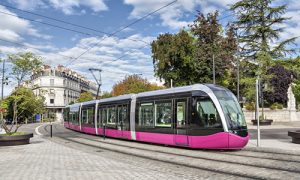
Public transportation is increasingly important in societies to cope with continuing population growth and expanding urbanization. Approximately 60 billion public transport passenger journeys are carried out in Europe each year (13 billion in North America)[1]. Public transportation is regularly promoted as the key solution to reduce individual cars traffic congestion, parking challenges and environmental pollution and turns out to be typically cheaper than using private vehicle. However, the use of public transportation and transit, whether it is in local and regional buses and trolleybuses, regional and suburban trains, metros, trams or ferries, can sometimes generate a very frustrating experience for passengers and progress still need to be made to improve passengers’ journeys. Passengers are regularly struggling to get real-time information on waiting time and schedules, to plan their journey or to be informed in case of unforeseen circumstances that may disrupt public transit information. The Internet of Things (IoT) is spreading in public transit to power smart intelligent transportation systems (ITS) to offer many benefits to passengers. ITS solutions can include applications like real-time vehicle tracking, notifications in case of an unexpected event, personalized travel journey, ticketing / payment systems, cloud / analytics services, as well as traffic management and control. Many cities started smart transportation initiatives to optimize their public transportation services and enable users to be better informed and make safer, more coordinated, and smarter use of transport networks. McKinsey notes that, by 2025, cities that deploy smart mobility applications have the potential to cut commuting times by 15% to 20% on average[2]. And Berg Insights estimates the economic value of public transport services to around € 155-165 billion per year in Europe and to around € 70-80 billion per year in North America[3].
IoT sensors and devices can help in multiple way to improve public transportation services. Vehicles’ location can be achieved through embedded GPS systems using an internet connection to transmit the GPS data to a central traffic management system. Several types of IoT networks can be used to collect and transmit the location information and vehicle status, including low power wide area (LPWA) networks that can deliver extensive coverage even in dense urban areas. One the GPS information is received and analyzed, it can be relayed to passengers’ smartphones or to onboard or offboard digital displays to share information, thus enabling them to get real-time information on their journey and time arrival at a particular stop. In case of unexpected events that can disrupt public transportation – such as breakdowns, road closures, tracks or signal issues or bad weather conditions – IoT can help to re-route vehicles, notify passengers and find alternate options for their journey. IoT sensors can also be used for passengers counting to generate the data for ridership analysis: knowing exactly how many people are getting on and off a bus or a train, in which station and at what time, provide valuable inputs to adapt the public transportation means and to size the investment. IoT solutions can also help to deliver personalized travel information, based on a particular person’s travel habits based on preferred routes and / or station that person frequently uses. Anticipating a scheduled station closure or a planned re-routing, that person could be notified ahead of time.
Leveraging Kerlink industrial-grade IoT connectivity, powered by LoRaWAN technology, can efficiently help cities and municipalities to collect, analyze and leverage public transportation and transit data to reduce delays, optimize routes, predict and anticipate maintenance and improve the overall availability and reliability of the transit service. Kerlink industrial-grade IoT gateways and network management tools can efficiently power smart public transportation solutions to increase efficiency by collecting information in near real-time to increase transport operators’ profitability through higher operational efficiency as information flow improvement will lead to more efficient communication and environmental reporting. Passengers will also experience higher safety, punctuality, clearer and more frequent information based on the data collected through a reliable and performance carrier-grade IoT network. Cities will be able to increase the share of public transportation to raise their attractiveness, reduce traffic congestion and improve their environmental footprint, for a better quality of life.
[1] http://www.berginsight.com
[3] http://www.berginsight.com
Smart Security

If cities are essentially concentrating the educative, economic, political and cultural activities of territories, they are also unfortunately concentrating most of the crimes and threats such as planned robberies or thefts, vandalism, organized terrorism, industrial accidents, major natural events or even man-made disaster. As the global urban population is increasing, preventing such incidents and ensuring citizens’ safety is becoming a paramount duty of urban authorities and smart city governors to improve cities attractiveness, security and quality of life for inhabitants, tourists, students and workers. If security and safety have traditionally been enforced by laws and order departments of cities, the increasing migration of people to cities make it more and more difficult for limited police forces to ensure security effectively. The traditional methods used by police forces to monitor the city populace for signs of potential risks will quickly be insufficient to maintain law and order in the future. IoT can thus benefit cities authorities to create smart city security projects for safeguarding the lives of their citizens. IoT can help to quickly collect data from multiple physical environments to fuel intelligent security and disaster management solutions that can identify, anticipate and predict threats and quickly get public safety departments ready for responding immediately and respectively to qualified emergency situations. The global market for IoT for public safety was worth USD 844.2 million in 2017 and is expected to reach USD 2010.44 million by 2023, at a CAGR of 15,60% over the period[1].
IoT sensors and devices can help to deploy a wide range of solutions to improve security. IoT sensors equipped with microphones and placed everywhere in the city can detect gunshots. Once collected, the information is sent to a cloud platform whose artificial intelligence (AI) software analyzes the sounds, compares them with references and identifies a gunshot. Calculating the time needed by the sounds to get captured by the microphones, the application can estimate the place of the gun and immediately inform the police. Connected video cameras, combined with video analytics and deep learning-driven AI can analyze people behaviors and detect anomalies, like indications of violence, to notify nearby security personnel instantly. This may improve the quick reaction to crimes or even help to prevent many criminal acts. Monitoring crowds in public places, busy streets, shopping areas and metro / bus / railway stations to avoid any security incidents is key. IoT sensors and devices can help to detect objects made of particular materials or having a specific shape, even if they are hidden, and AI algorithms can further help to identify potential risks before personnel make further direct investigation. IoT sensors can be used for crowd monitoring, for example to help to count people using specific structures, like footbridges or bleachers, warn them in case a specific threshold is reached or even close the access doors. Access control is another key topic: the access to specific public areas like airports, train stations, public buildings or even entertainments and sport places like theaters, stadiums or swimming-pools can be controlled and restricted combining technologies like IoT sensors and AI, connected to a private and secure network. Authentication might be simple, for example based on ID, tickets or members cards or more complex like biometric scanning. Access control in public transportation can be made simpler and safer through IoT-enabled ticketing, for example by using RFID-enabled tags or tickets that can be quickly scanned and checked by beacons, enabling large volume of operations without compromising passengers flow at turnstiles and security. This can improve the use of security personnel and keep them ready to handle more serious situations. IoT-enabled small battery-powered trackers, using a long range and low power IoT network, can help to protect cities assets (like bins, signs, street furniture…), citizens’ belongings (like bikes, bags, trolleys…) but also children on their way to school or pets if they run away from home. Panic button devices, using instant geolocation and pre-registered emergency numbers and contacts, can not only be worn to secure elderly people, especially if they suffer from diseases like Alzheimer, lone women and children, but they can also be used by cities employees and security personnel in case they work alone or execute tasks with a potential risk of fall or accident.
Leveraging Kerlink IoT solutions to design a private IoT network can help to deploy scalable and future-proof smart security solutions to improve cities overall safety and quality of life. Public safety is a serious topic and cities officials need to have the rights insights at the right time to achieve better detection of threats, make faster decision and trigger better targeted interventions, while keeping a constant and strong link with the population. Kerlink industrial-grade IoT gateways and network management tools can efficiently power smart city security solutions to connect IoT sensors and devices that continuously collect small amount of data in many different places. Mixing performant indoor and outdoor carrier-grade coverage enable versatile connectivity even in dense environment. If security is not only a matter a technology and should remain focused on human analysis and final decision, IoT can however help to perform multiple tasks at the smart cities’ security strategy.
[1] https://www.marketresearchfuture.com
Smart Environment & Sanitation

Rapid and more or less controlled urbanization often goes hand in hand with the appearance of permanent nuisances such as noise, pollution and sanitation issues. Although city-dwellers may be used to noise and air pollution and poor sanitation conditions, that does not change the fact that exposure to these nuisances can be detrimental to physical, mental and emotional health. For example, the today average noise level of 98 decibels (dB) exceeds the WHO value of 50 dB allowed for residential areas[1] and ambient air pollution itself “accounts for an estimated 4.2 million deaths per year due to stroke, heart disease, lung cancer and chronic respiratory diseases,” according to the WHO[2], costing societies more than $5 trillion every year, according to the World Bank[3]. If older towns and cities sometimes do not gather the conditions required to effectively combat these nuisances due to their construction methods, infrastructure or equipment, new towns should integrate these considerations into their very design, so that these issues are addressed from the outset. It is thus increasingly important for urban planners to take proactive steps to implement large-scale means of collecting data in real time. If this is especially true for places like schools, universities, hospitals or retirement homes where children and elderly people need to have a quiet and healthy environment to study, rest or recover, all citizens expect to enjoy a better quality of life in a greener environment.
IoT sensors and devices, connected to an industrial-grade IoT network, can help to monitor, collect and control data for these three challenges. First, IoT sound level sensors, like sound pressure level (SPL) meters, can be used for acoustic measurements in various environment, indoor and outdoor, to raise alarms in case defined thresholds are reached and to enable decision makers to take appropriate actions to reduce environmental noise and sound pollution. Second, IoT sensors and devices can help detect and measure emissions of pollutants, particles and obnoxious gas in the air. If the two main air pollutants of concern in cities are nitrogen dioxide (NO2) and particle matter (PM2.5), because of their serious impact on health and environment, other key pollutants pose serious health and environmental hazards, like carbon monoxide (CO) and dioxide (CO2), ozone (O3), PM1, PM10, PM100, sulfur dioxide (SO2) and hydrogen sulfide (H2S) among others. IoT sensors can also monitor and records key variables like air temperature, wind, humidity and UV levels to collect additional data for combined intelligent processing and actionable data modelling. Third, IoT sensors and connected devices, using a low power wide area (LPWA) IoT network can help to improve pest control and to fight vermin infestation. Electronic pest control IoT devices do not use any chemicals, messy traps, poisons or other potentially harmful substances. Their purpose is to repel rodents and they are usually based on electromagnetic, ionic or ultrasonic technology, sometimes all in one. Moreover, state of the art battery-powered sensors and traps can inform, in real time, vermin control teams’ central hub when nearby motion has been detected and when a trap has been armed, unarmed or armed but without a catch, reducing useless visits and related costs.
Leveraging Kerlink IoT solutions to design a private IoT network can help to control sound pollution, air quality and pest proliferation in urban areas and cities, to provide data-driven insights on sound levels, pollutants, particles and obnoxious gas levels in the air or rodents populations for better decision making. Kerlink industrial-grade IoT LoRaWAN gateways enable to deploy a robust and reliable IoT network, even for indoor coverage in undergrounds, basements, tunnels or technical pits. Cities authorities, planners and operators can leverage a private IoT network to react and take appropriate curative actions based on instant alerts or records. They can also work on preventative measures based on modelized patterns, for improved operational efficiencies and optimized investment, to create better living conditions and stronger sanitation.



